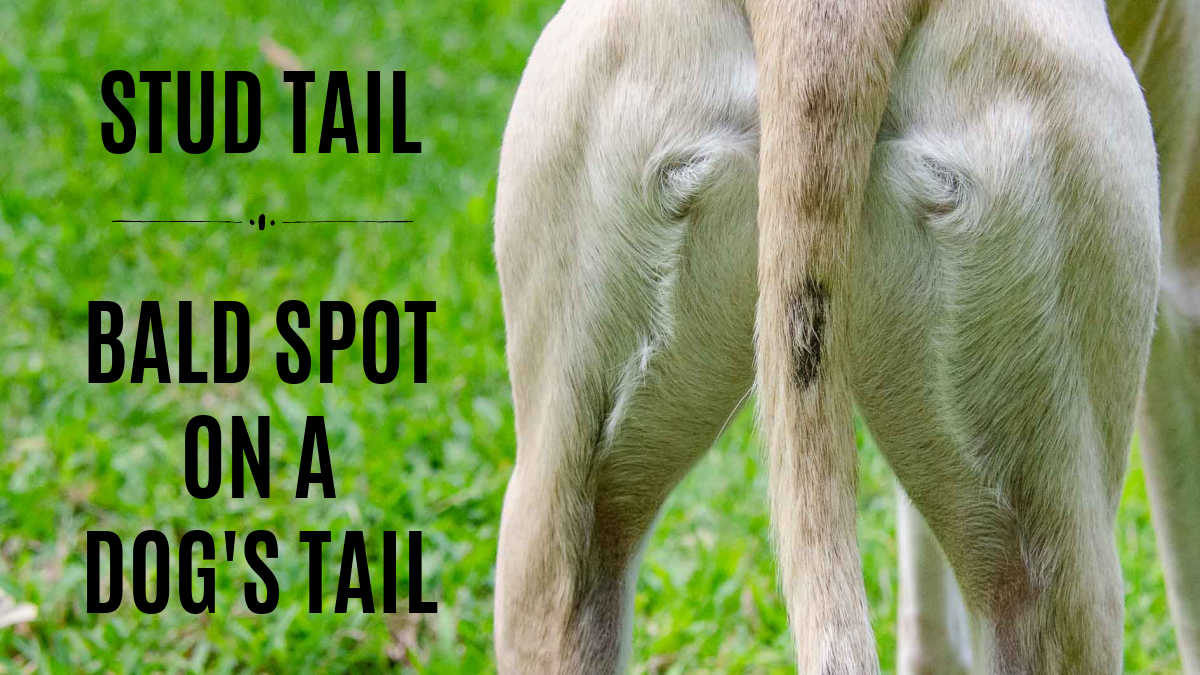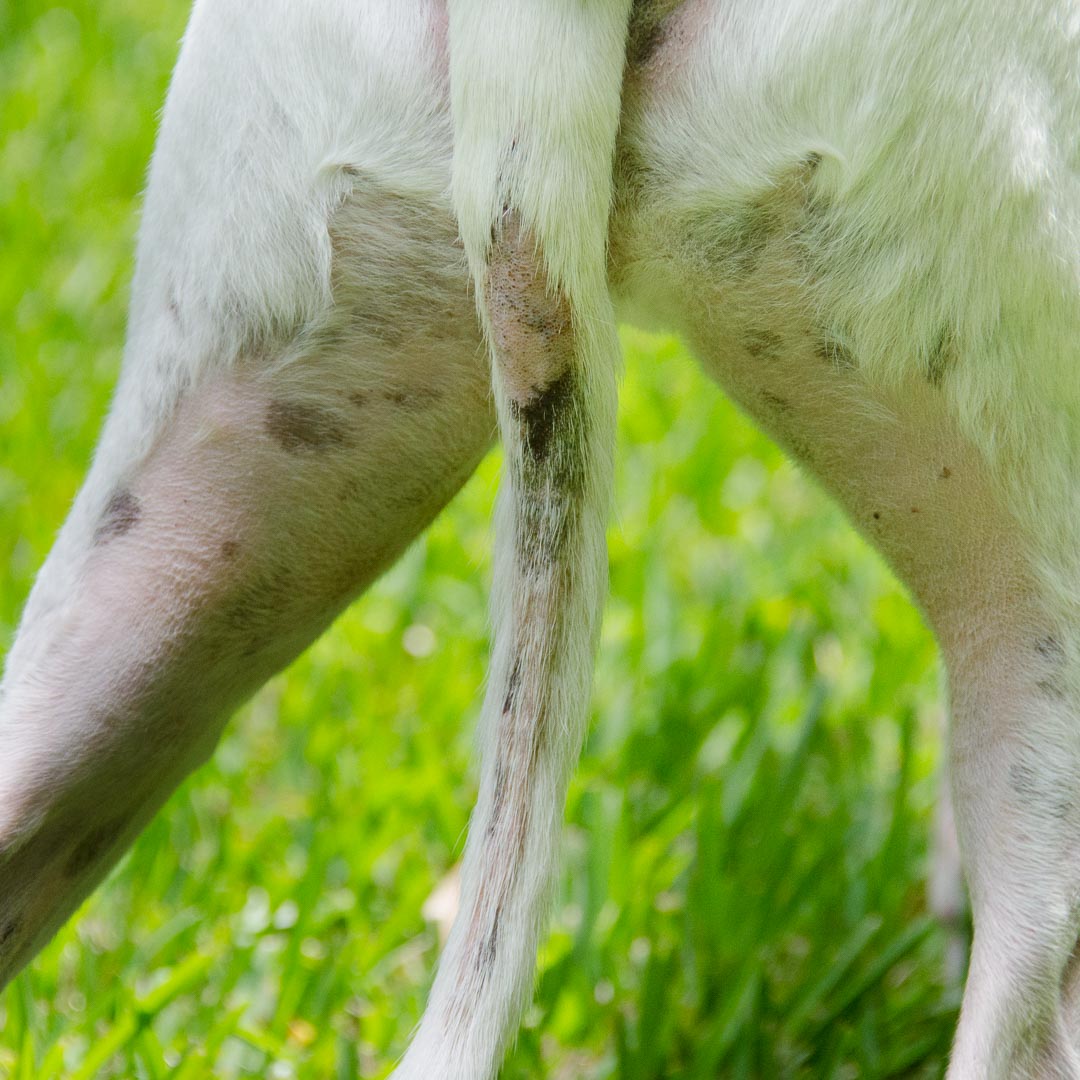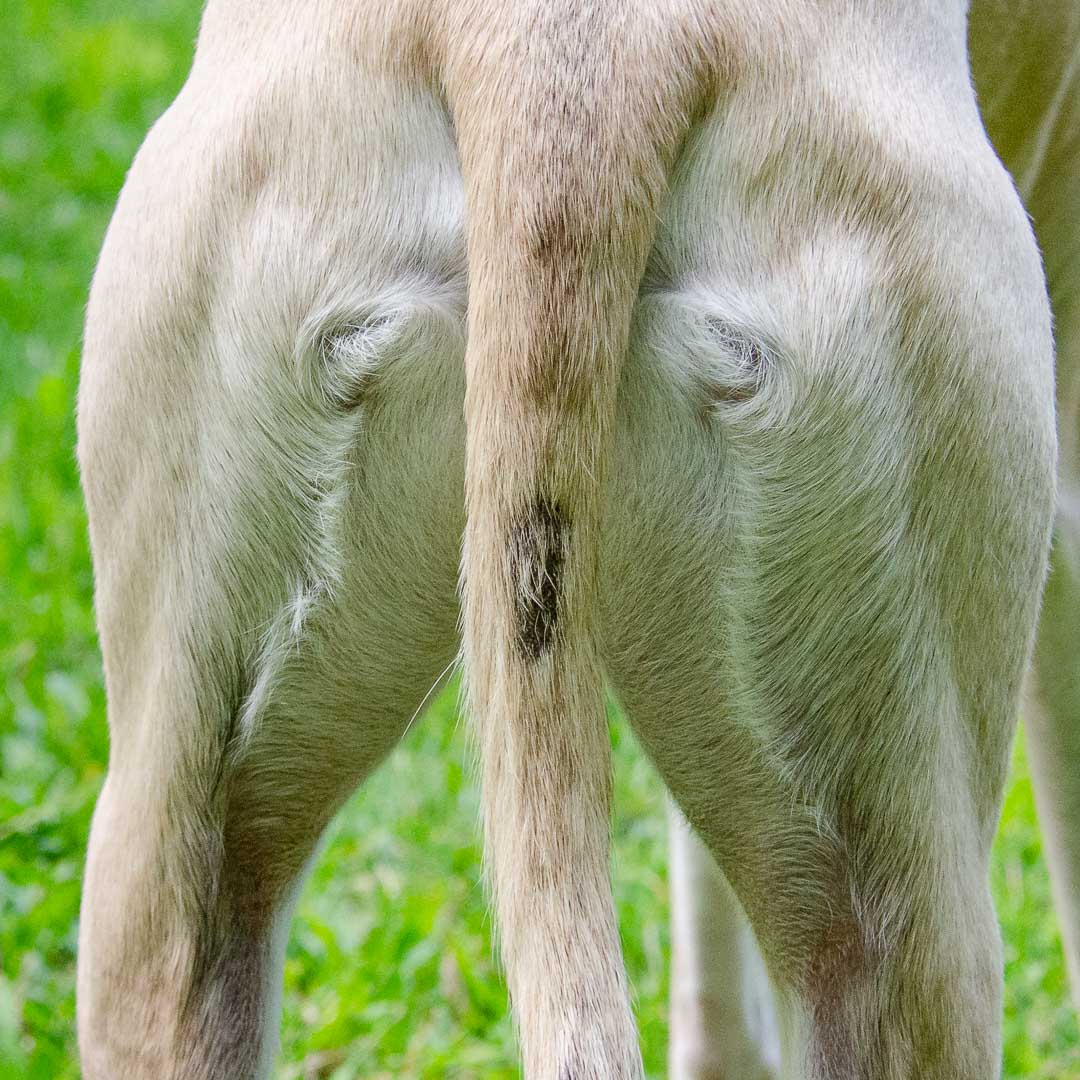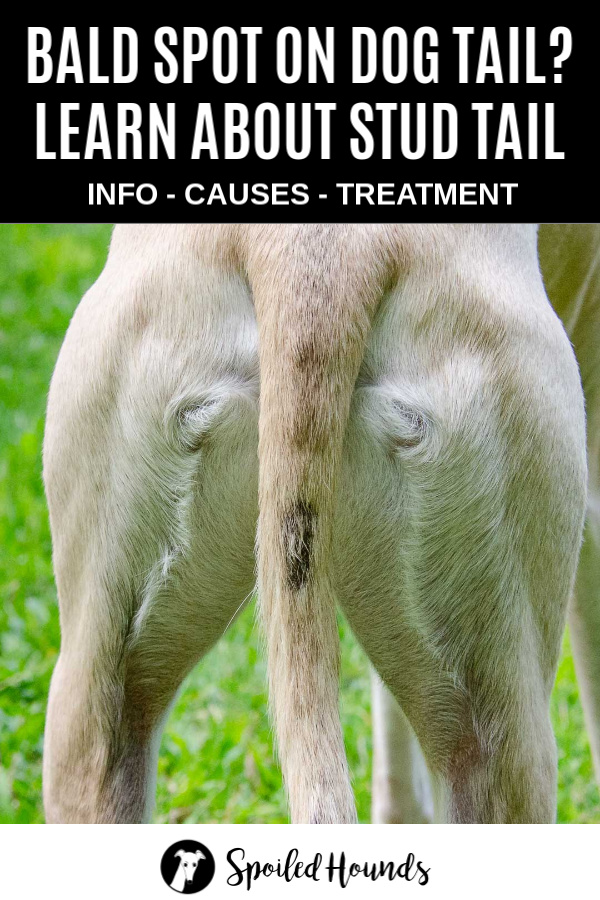Does your dog have a mysterious bald spot you can’t explain? If your dog has experienced hair loss or has a large bald spot on the tail, it might be a case of stud tail. While it might seem scary at first, stud tail is a very common and treatable skin disease in dogs.

What is Stud Tail?
Stud tail is the basic term for the more scientific term, tail gland hyperplasia. Simply put, this is a dog tail infection. It is a condition that occurs in a dog’s supracaudal gland, a gland located in the upper to middle half of a dog’s tail.
This gland is also known as the violet gland and contains sebaceous glands that secrete sebum, an oily substance. These glands are normally responsible for producing sebum within hair follicles that keeps the hair on the tail soft and flexible.
Supracaudal gland hyperplasia is when the sebaceous glands secrete abnormal amounts of sebum. These oily secretions are one of the most common causes of stud tail.
You can read more about a dog’s supracaudal gland on the Dog Discoveries website.
If you see your dog losing hair on its tail, please reach out to your veterinarian for a proper diagnosis. Your vet can do a physical examination and give you professional and personal advice just for your dog.
Stud Tail Symptoms
The symptoms of stud tail can be pretty easy to spot, once you know what to look for. If you’re concerned that your dog might have stud tail, be on the lookout for these common symptoms.
- Greasy and sometimes matted hair at the base of the tail
- Missing hair at the surface of the base of the tail
- Blackheads (comedones) on the skin at the base of the tail
- Waxy substance on the skin and hair at the base of the tail
- Skin infection at the base of the tail
- A foul odor
If you begin seeing several of these symptoms together, be sure to begin treatment as soon as possible. The longer the condition is left untreated the worse it will get. It’s better to act sooner rather than later.
This might start out looking like a cosmetic problem or a mild condition, but it could get worse if you ignore it. The good news is that there are things you can do to help your pup.
Something fun: 37 Naughty Whippet Dogs Destroying Things

Common Stud Tail Questions
What causes stud tail?
Stud tail is caused by two main factors, the first being if the dog’s androgen levels are high over an extended period of time. These are levels that are heightened during the mating stage, so if the levels are heightened for too long it can cause the condition.
The second cause of stud tail is from is an outside agitator such as fleas. If these pests make their way to the tail gland and start sourcing blood from there, the gland is likely to get inflamed. If you notice your dog has stud tail, look for flea bites to see if that could be a factor.
It could also be caused by excessive oil buildup, much like acne in humans. In dogs, it’s the buildup of sebum that causes these symptoms.
Is stud tail contagious?
No, it’s not contagious. One dog can not give the condition to another. Stud tail stems from irritation or infection within an individual dog’s immune system.
Does stud tail go away?
Yes, it can! As long as the proper steps have been taken, stud tail will go away. While, as stated, it’s not a serious condition. You can ignore it as long as the area does not look irritated or infected.
Feel free to try some of the below-mentioned remedies. See your vet if the condition does not clear up or show signs of irritation or infection. There is a risk of secondary bacterial infections if it is left untreated.
Note it can take several weeks for noticeable improvement.
What do severe and mild cases look like?
Here is how to tell whether your pet has a mild or severe case. In mild cases, there might not be any inflammation. You might just notice a bald spot that looks extra greasy.
Please understand that a balding spot on a dog tail doesn’t always mean they have stud tail. That’s why a professional opinion from a vet is so important.
In severe cases, you will notice a very foul odor. The tail might be swollen at the bald site, and your dog might even suffer secondary infections. If you think your pet has a severe case, please reach out to your veterinarian.
Does Stud Tail Happen In Just Males?
Even though the name “stud” might make you think it’s a dude thing, stud tail can happen in dogs that are adult males, intact males, and even females. It isn’t something that happens to just boy dogs.
Is this the same thing as a sebaceous cyst on dogs?
No, stud tail isn’t always the same thing as a sebaceous cyst. If you think your dog has a cyst on its tail, please reach out to your veterinarian.
Stud tail can lead to a secondary dog tail infection, so it is always a good idea to reach out to your veterinarian and don’t just ignore it.
Interesting article: Why dogs eat poop and how to stop it.

FYI – This post contains affiliate links. As an Amazon Associate, I earn from qualifying purchases.
Stud Tail Treatment and Remedies
Since stud tail is such a common problem in dogs, there are lots of home treatments out there to try before heading to the vet. Here is a list of a few remedies for stud tail treatment.
- Witch Hazel. I use Dickinson’s wipes and wipe them on the area daily.
- Stud tail shampoo for dogs using Benzoyl peroxide shampoo for dogs.
- My vet recommended Stridex sensitive skin pads but they weren’t effective. It could potentially be worth a try if you have a mild case of stud tail.
- Antiseborrheic Shampoo – formulated to reduce inflammation and promote healing.
Keep in mind these treatments are for clear-cut mild cases. If your dog is experiencing any severe symptoms, bypass the home remedies and take them straight to the vet instead. Your dog may need antibiotics or other medications to clear up the condition.
Do You Have Any of Your Own Remedies?
Comment below and let me know If you have any of your own stud tail treatments I didn’t mention.
📌 Pin this to save and share 📌

I have been over exhausted with this
Today my dog is getting nurtured. Hopi g the tail gland will go down..??
Mine has tried different things still there
Same with mine. At least it’s okay as long as the spot doesn’t look irritated or infected.
Are dogs had a tail have a problem, and we finally found that soaking it in warm water, and then basically squeezing it like a pimple works the best. Also continually rubbing Neosporin all over the entire tail has finally helped a bunch of old patchy skin fall off, and the tail is finally looking normal and pink underneath again like regular skin and hair growth is returning.
Good to know that is working for your dog. It’s something worth giving a try. All the other methods haven’t worked with my hounds so far.
My dog has had this for years and I tried washing with Benzoyl Peroxide shampoo and applying benzoyl helps per my vet’s directions. I did this diligently and then it almost came back and for whatever reason even more hair fell out and the patch is bigger. I wanted to see if the Neosporin really worked ongoing and if the hair is mostly back as I will ask my vet about it. Also my dog had this for several years and even though I took him to vet after vet it wasn’t diagnosed for a long time and the skin had blackened.
Above Trying to say benzoyl “gel” .
I tried MTG Main Tail Growth and another product with no luck. I did try the hot packs and squeezing at the beginning along with the Benzoyl shampoo and Gel and at that time the hair was almost grown back for a few months. It has gone down much of his tail and for many years the vets thought it was hypothyroidism but that the thyroid meds did not help his tail. I just read about Apple cider vinegar and applying that. Our dog’s skin is blackened and then when I start working on it daily, the black falls off but still no hair. The vet says it is scarred over but I have gotten some hair to grow back and it is about half the size it was. Would love to hear other ideas and know if the Neosporin still works?
As much as I’d love to use Neo as a treatment for this it won’t work for us my stupid dane loves the stuff and will lick it off as soon as it’s put on. Going to try it and duct tape a sock over her tail to guard it should take her about 20 seconds or so to get the sock off once we fall asleep
Good luck! Nothing so far has worked for Luke and Zephyr’s stud tail. The vet says it is fine so they will just continue to have the bald spot.
I used apple cider vinegar with water and it worked. 70% apple cider vinegar, 30% water spray everyday for a month.
Did it work? I’d like to try this natural remedy
My dog has basically had stud tail since he was a puppy. He was neutered at 8 months and it went away instantly after that. He is now 2 1/2 years old and it still comes and goes. His hair will grow back and then months later it will go bald. So I’m wondering if anyone has experienced a reoccurrence in this? He does get irritated with it but it isn’t oily, red or foul smell.
Our guy got neutered at 9 months, he’s 4 now and it’s the second tome in 6 months that he’s gotten it. Not waxy or smelly, but very red and irritated.
I’ve noticed it seems to flare up after periods of high stress for him (long car rides which he hates, for example).
My dog has this . Comes and goes. He is neutered , not sure what triggers it. No infection . Vet says it’s rare but normal leave it be
My dog it seems like every spring. Usually dry skin from winter or dandruff and/or flea bite that itched a lot. I bathe him. Towel dry. Then brush him. Wipe area with witch hazel. Then slather on triple antibiotic ointment no sold at Walmart. Keep it slathered. Then it’s fine in about a week… Then to be sure it was not a bunch of fleas I. Go spray my yard with insecticide that is safe for dogs after it dries.. then I reapply once I’m spring and again near end of summer… Every 2-3 months I bathe him with oatmeal shampoo and flea and tick shampoo.
I have a bitch with very short hair in a long patch
On the bottom of her tail. The rest of her coat is long and lovely. Her tail should be 4 to 5 inches long it is 1/2 inch in a patch about ten inches long. No fleas, chewy, extra have tried allederm directly on the patch, melatonin by mouth, coconut oil also, changed food! Cannot figure out what is going on? Any suggestions?
I honestly don’t know what it could be since the patch is on the bottom of her tail. I recommend you to take your dog to the vet to find out what could be causing it.
I haven’t started treatment yet but my vet said to use lots of vitamin
Our lad has this for over 2 years now, not getting any worse nor any better, plus no foul smell. We have tried lots of things but to no avail at present washing the area twice daily with soap and water still no difference, any suggestions or help appreciated
It is common for stud tail not to clear up no matter what you try. You could have your vet take a look and see if there is any need for medical treatment. If not, it’s perfectly okay to just leave it as long as it isn’t showing any signs of irritation or infection.
What has helped my dogs most significantly is to reduce dog-initiated biting/licking which results in increased soft tissue & skin irritation/infection/&
inflammation and potential hair loss. My Vet suggested/ & endorsed aministering the appropriate mg of the OTC anti-itch ALLERGY medication (Diphenhydramine) aka Benedryl! Upon any hint of a breakout or biting or even increased tail interest by my dogs, commences a vet approved Benadryl regimen to help counter the itching and biting which tends to keep all or most skin irritation away or highly reduced. The evidence is that none of my 8 Goldens have ever lost any hair and they rarely bite their tail. I also use some topical antibacterials as well as help them maintain very clean tail skin hygiene. It has Been and remains one of life’s honors to love & care for my fourth pair of golden retrievers. From time to time they (mostly males) have experienced minor symptoms. I am not a veterinarian. My dogs get 25mg benadryl/approx 50lbs body weight every 18 to 24 hrs as needed to help reduce itching hence reduce biting/licking, hence minimize skin irritation. Absolutely get dosing directions from your dog”s Vet based on your dog’s health, age, other existing meds etc, etc.. Hope this helps one of our little four legged little besties out there.
Thank you for the information on what has helped with your dogs.
My dog has the same issue and I was wondering if I could put honey on the missing spot or put honey in his food?
Manuka honey is used by some folks to treat wounds but I have not seen any reports of success with it for stud tail. As far as putting honey in food, while it is safe in small amounts it is high in sugar, can lead to tooth decay, and weight gain.
My dog has had stud tail for about a year. It’s mostly dry and no odor or irritation. Just a big spot of hair loss. After I started applying Caster Oil daily I’m noticing new hair growing in. He doesn’t ever chew on his tail so he doesn’t bother the spot and the oil is allowed to stay on and work. If you buy Caster Oil make sure it’s in a glass bottle, cold pressed and says “no hexane”.
My dog is a female, lab, and she has had stud tail for years. Sometimes the spot is dry and grey in color, then when I mess with it (squeeze all the blackheads and “white pimples”, clean off the dead flakey skin) the pink healthy skin returns, but so do the blackheads and pimples. It’s infinitely frustrating. Been to the vet twice; antibiotics and chlorhexidine spary, didn’t work. Going back to cleaning the area, exposing healthy skin, squeezing out impaction, peroxide, Neosporin, and acne cream. We’ll see.
My dig has like little black spot and it looks my blackhead in the middle of her tail, I noticed she had it about a year ago, she’s 4 and spayed since she was 9m. I noticed a little bump in it and when I squeeze it a something comes out with when you squeeze a pimple. Is that Stub Tail? Im sorry if someone already asked but I worried it could be something else
Let me add she’s a Chihuahua Mixed Yorkie.
From the way you described it, I don’t think it is stud tail. There is usually a bald area and not just a blackhead. I recommend getting it checked by a veterinarian in order to know for sure and get proper treatment if needed.
Omg..I have been dealing with this for 2 years now. It’s non stop. It has to be an autoimmune disease?
Stud tail is not an autoimmune disease.
We have 2 adult male (intact) Labs, 8 & 4 yrs. They’re pets first, live with us in the house, but are hard-core field dogs (we hunt over 50 days a year). They’re lean and very fit, eat good food, drink untreated deep well water and get tons of exercise. No fleas, ticks or exposures to chemicals as we are an organic ranch ( no pest or herbicides sprayed on property).
So, it’s obviously not a lifestyle thing that has caused this condition. We are at a loss as why these 2 have it but never saw the condition on the last 4 Labs we’ve enjoyed over the past 2 decades.
Harmless yes, but frustrating especially when some self-proclaimed expert says we have a flea issue (eyeroll).
Nothing yet has shown any positive results so we’ll keep checking back in the event a breakthrough remedy comes to light.
Thanks for hosting this forum Renee!!!
JW in Texas.
My 8 year old, intact, male Mastiff mix has had a 1″ diameter bald spot in the middle of his tail now for 7 years. It started off as a hot spot and has never gotten any better despite many different creams (steroid, antifungal, etc) and many oral pills including antibiotics from our Vet. I’m going to try some of the remedies listed here and will eventually report back. I hope one of them works.
This is the first time my dog Otis has it. I’m not convinced he has it yet. He has an oily consistency to his poop and he’s loosing hair, not bald yet, his tail. And he’s recently lost weight. I don’t know if he’s grieving the loss of our other dog but it’s been a few months. But thanks for the information I’ll probably get him some
The oily consistency of poop and loss of hair in other parts of the body are not stud tail symptoms. It’s definitely worth a vet visit to see if there is something else causing those issues.
Thank you so much this pin, as we too are trying to rid my whippet’s stud tail. Although it’s not irritated or infected, it just looks bad and he’s such a beautiful dog. Luckily he’s not itchy or biting at the area. Our breeder told us to give fish oils orally and rotate using Lotrimin and vitamin E , and we had previously used neosporin before we were told about Lotrimin. Every other day we shampoo with a Benzo-peroxide based shampoo and doing just the affected area , leave it on for 10 minutes before rinsing. He’s not neutered yet, but we have plans to so, maybe that will help as well. Hope this helps you🤗
Hey guys! My whippet has had it for a good year now. She’s 11 this week 🎂🎉 Due to my relationship breakdown i have had to move house twice in last 18 months, so i know that stress, and not having her daddy living with us any more has had an impact on her. Although stress doesnt seem to be a factor in stud tail symptoms. The place I moved into was infested with fleas which has taken me ages to eradicate. The poor doogie had gone from it being me, her and my ex for all of her life, to just me and her…and to then be getting bitten by fleas in her new forever home, when she’s never had a problem with them before! I hate to think she’s sad, i know its certainly been a rough ride for me!
Her woofday this week so will give her extra walks and lovely whippet huggles 🤗🐾
Thank you all for the good advice x
How is your whippet doing? My 11yr. old pitbull just got this bald spot on her tail overnight! It doesn’t seem to bother her, she’s not under any stress that I can see either. She has always been so healthy that the sight of it freaked me out a bit. I think it is the same thing Cleo has.
My whippet is doing fine. It’s just a bald spot and never has bothered him.
Hi, My nearly 10 year old entire English Springer Spaniel has developed this bald spot stud tail over the last few years. I’m worried because of his age that it could signify something else. He’s also almost become worse about scenting other dogs and the environment. He’s always been intact and wasn’t this bad when younger. I’d appreciate any thoughts 😌 🙏🏼
I recommend having your vet check out the spot just to make sure it’s fine and nothing more than stud tail.
Just saw this exchange. All three of my Whippets have dorsal tail alopecia. This is not uncommon in some breeds of dogs. It isn’t caused by fungal or bacterial infections, abrasion or external parasites (e.g. fleas). Minoxidil doesn’t help. Once the hair follicles shut down production they rarely recover. I, too, have tried a number of ways to reduce the comedomes with little success. Try to keep the plugged follicles as clean as possible. The syndrome isn’t pathological: it’s unsightly, but also increases the risk of solar damage to the skin so sunblock is a good idea. BTW: I am not a dermatologist, but I am a veterinarian.
My 11 year old female pitbull just developed this bald spot on her tail over night. It doesn’t seem to bother her, is it something to worry about?
If it doesn’t bother her, it’s fine. But just have the vet take a look at it when you go for a checkup visit.
Thank you and I read all the replies. My 9 year old smooth saluki recently developed this and I treated with the benzoyl peroxide shampoo. My vet says the skin looks healthy and not irritated and to leave it alone but it is not getting better – no oozing. He is a sun lover so I will try the sunblock when he is in the sun and will consider trying the Neosporin.